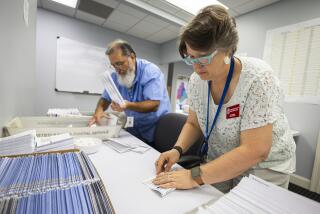Parties Gambling to Get Out the Nonvote
- Share via
WASHINGTON — With the pool of swing voters drying up quickly, Democratic and Republican groups are increasingly courting unregistered and unreliable voters, a strategy some campaign experts call expensive, unpredictable and necessary.
“There’s no question both parties are investing more than I’ve ever seen in mobilizing marginal voters that are likely to go in either direction,” Ed Kilgore, Democratic Leadership Council policy director, said Wednesday at a panel hosted by the Free Congress Foundation.
Typically referred to as nonvoters, unregistered and infrequent voters were often ignored by pollsters and strategists, who preferred to invest time and dollars reaching the voters who were most likely to show up at the polls on election day.
With polls in key states deadlocked, campaign bank accounts flush and most likely voters leaning toward a candidate, the two major parties and like-minded groups say they are willing to look for new targets.
The Republican National Committee says it has registered 2.5 million new voters. America Coming Together, a liberal independent group, has raised more than $75 million for voter registration efforts. Groups like Punk Voter and Rock the Vote also are targeting younger voters with increased intensity.
But the efforts, Kilgore said, are costly and can be risky. He cited a University of Michigan study in 2000 showing that nonvoters tended to be disconnected from their communities. They are less likely to look to politicians, labor leaders and religious leaders for advice. They tend to shirk party affiliation.
“The very important thing to remember about nonvoters is that they’re hard to reach,” said Kilgore.
“Parties trying to mobilize nonvoters face a dilemma. If you do it over the radar screen with a message, you have to shout pretty loudly and risk alienating swing voters who are almost certain to vote.”
He and other panelists attended a session organized by the Free Congress Foundation, a conservative think tank in Washington, to assess the state of the presidential election.
Democratic pollster Anna Greenberg said she had found strong concentrations of dormant Democrats in the nonvoter population. Large numbers of the nonvoters she polled were Latinos, unmarried women or people ages 18 to 25 -- groups that tended to favor Democratic candidate John F. Kerry, Greenberg said.
“That where the Democrats will get more bang for the buck,” she said.
Greenberg said that Democrats did not have to change their message to attract the attention of these nonvoters. And with allied groups funding the registration drives, the Kerry campaign does not have to change its advertising buys.
“It would only be risky if you’re taking money out of television and putting it in GOTV [get out the vote]. That’s not the case here,” she said in an interview.
But Republicans’ constituencies also are represented in the population of disengaged. Several panelists noted that 4 million evangelical Christians, reliable Republican voters, did not vote in the presidential election in 2000.
“I don’t know if there are really 4 million evangelicals who didn’t vote in 2000, but I know that there is a lack of enthusiasm in the Republican and conservative base that is the principal goal of President Bush to erase,” conservative columnist Robert Novak said. “I think he has to energize his base.”
More to Read
Get the L.A. Times Politics newsletter
Deeply reported insights into legislation, politics and policy from Sacramento, Washington and beyond. In your inbox three times per week.
You may occasionally receive promotional content from the Los Angeles Times.











